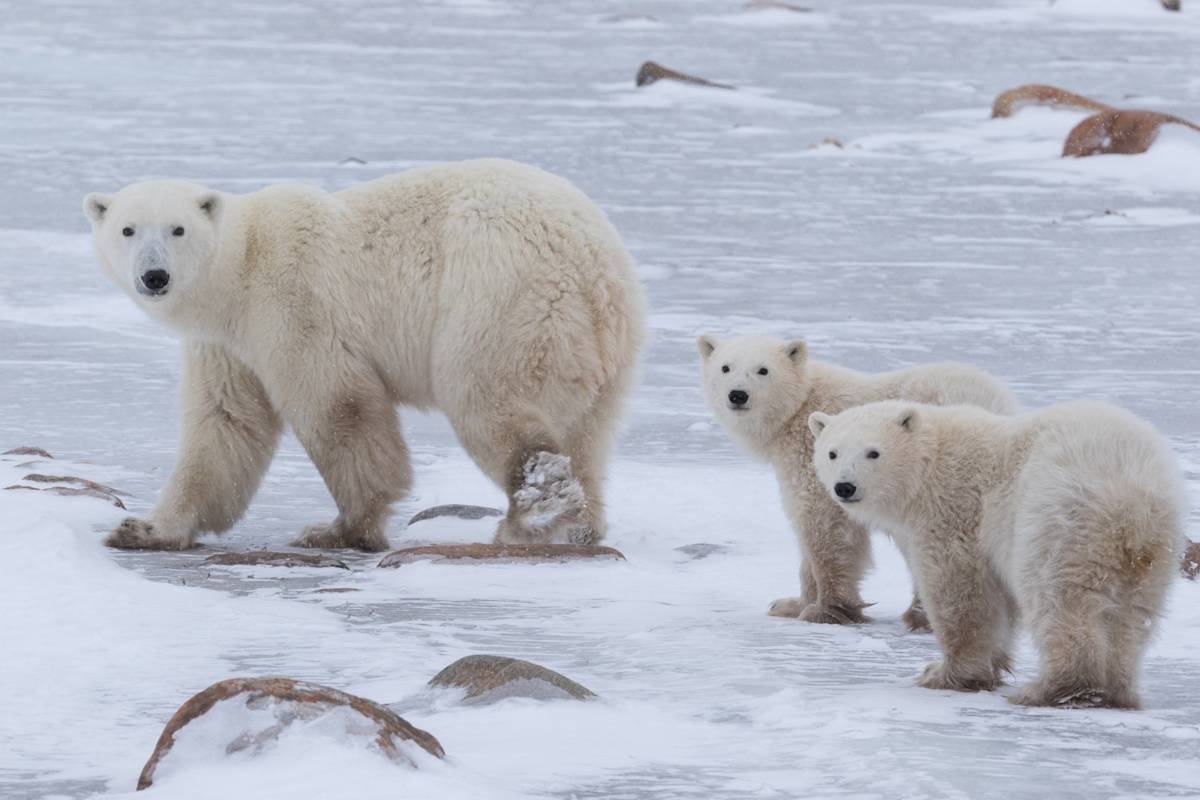Key Results: Polar Bear Survival Depends on Sea Ice
Polar bear survival is directly related to Arctic sea ice, as they need the ice platform to hunt their main prey, seals. When polar bears are forced onto land by melting ice, terrestrial food is an insufficient replacement, with prior research finding that survival and reproduction are constrained by bears’ capacity to fast. This new report finds that under 2°C of warming, southern Hudson Bay will be ice-free for 174 to 182 days, which would impair reproduction and strain survival. Western Hudson Bay will maintain sea ice for longer, with 163 to 168 ice-free days. Analyzing the projections from 20 climate models, the Western Hudson Bay region becomes an unsuitable habitat at 2.2°C or 2.6°C. The southern Hudson Bay sub-population faces a more dire projection, with ice-free periods becoming excessively long for most bears at 1.6°C to 2.1°C. Therefore, if the Paris Agreement is breached, and the world surpasses 2°C of warming, this report finds that the southern population will disappear, and the whole of Hudson Bay’s polar bears will be at or near their survival limit. If we do surpass 2°C global warming, the timing of that breach and localized extinction depends on the rate of greenhouse emissions by human activities over the coming decades.
“Unregulated emissions could mean we see the disappearance of the Southern Hudson Bay subpopulation as early as the 2030s,” says co-author Alex Crawford, Assistant Professor at the University of Manitoba, adding, “Changing policies to achieve more aggressive emissions reductions could delay the breach of the 2°C threshold to the 2060s, maintaining the survival of Hudson Bay’s polar bears.”
Significance of Hudson Bay’s Polar Bears
Hudson Bay is home to two of the world’s 19 polar bear subpopulations, representing the world’s southernmost polar bear populations, which have long been considered an indicator of how the rest of the world’s polar bear subpopulations will fare in the future. Hudson Bay’s polar bears are the best-studied polar bears in the world, and this report includes models using over 50 years of data since monitoring of Hudson Bay’s polar bears began in the 1970s. Beyond serving as a “canary in the coal mine” for other Arctic regions, these polar bears hold significant cultural value for communities around Hudson Bay.
“This report is more detailed and alarming than previous studies, reinforcing that Hudson Bay’s polar bears are not on a good trajectory unless significant emissions mitigation measures are implemented,” says co-author Geoff York, senior director of research and policy at Polar Bears International, adding, “This cross-disciplinary, forward-looking and comprehensive analysis of all of Hudson Bay provides more actionable insights for policymakers and wildlife managers.”
Implications for Seals and Other Species:
As rainfall, rather than snowfall, increases in the Subarctic and Arctic, it will be more difficult for both seals and polar bears to make dens to give birth to offspring, with rain potentially washing away their dens. There are three seal species in Hudson Bay, of which the ring seals are polar bears’ preferred prey. This report highlights how less snow can impact seal pup survival, as ring seals need at least 32 cm of snow depth to dig lairs for their pups. Future studies could look at the sea ice thickness needed for other species, like caribou and walrus that travel across the ice. Future research may analyze future sea ice roughness, which determines where snow sticks and accumulates, and therefore where seals can den.
This research underscores the importance of swift greenhouse gas emissions reduction, and multi-disciplinary, holistic approaches to research, management, and policy.
About the Centre for Earth Observation Science (CEOS)
Established in 1994, CEOS (umanitoba.ca/ceos) is a leading research centre housed within the Clayton H. Riddell Faculty of Environment, Earth, and Resources at the University of Manitoba at the University of Manitoba (UM) focusing on understanding how ecosystems of the planet will respond to climate change.
About Polar Bears International
Polar Bears International’s mission is to conserve polar bears and the sea ice they depend on. We also work to inspire people to care about the Arctic, the threats to its future, and the connection between this fragile ecosystem and our global climate. Polar Bears International is the only nonprofit organization dedicated solely to wild polar bears and Arctic sea ice, and its staff includes scientists who study wild polar bears. The organization is a recognized leader in polar bear conservation. For more information, visit www.polarbearsinternational.org.
Media Contacts
Annie Edwards, for Polar Bears International
annie@fabricmedia.net
T: +44 07307 139782
Melissa Hourigan, for Polar Bears International
melissa@fabricmedia.net
T: +1 720-608-1919


















